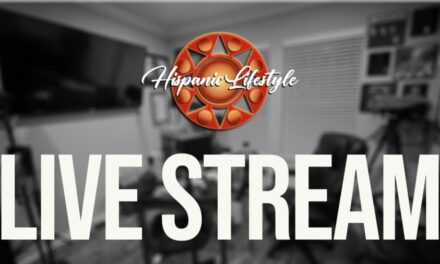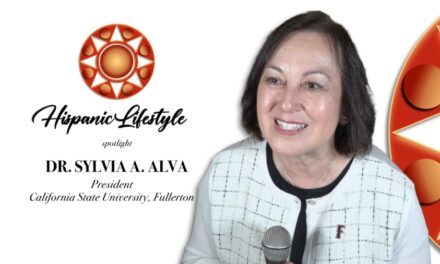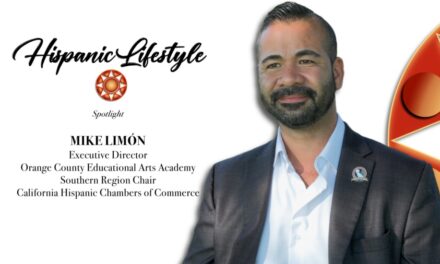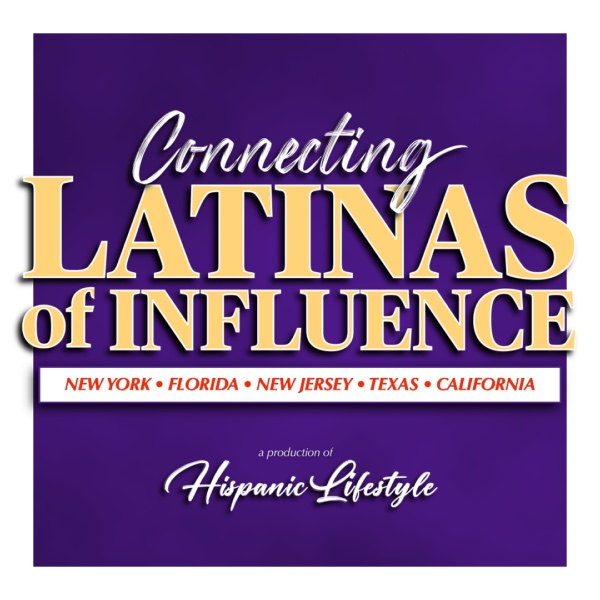
TURNING THE CHANNEL TO COLOR LATE-NIGHT TV
Turning the Channel to Color on Late Night Television
by Lauren Alicia Mendoza
It’s 2 p.m. and already the line of people has already snaked its way around the towering building. The crowd is dressed to impressed, with lots of short skirts and high heels and fancy dress shirts in sight. The energy of the excited group is the same as the crowds waiting outside any trendy venue near Hollywood and Highland and one thing is clear – this is the place to be.
Once inside the building, the atmosphere feels more like an exclusive L.A. party than a talk show set. Buildings tower above, bright lights flash as the music bumps and people start moving to the rhythm, anxiously waiting for the show to start.
The lights flicker, the sound of a cow bell from the band clangs, and War’s song, Low Ride. starts to play as the popular host emerges from behind one of the façade buildings.
The audience cheers. Then he appears – dancing to his theme song. He is George Lopez.
Audience members Alex Rodriguez and Margaret Vasquez are enthralled.
“I think it’s great to finally have someone who speaks Spanish on a late night show,” says Rodriguez about Lopez.
Vasquez excitedly echoes the sentiment.
“I watch the show, first of all because he’s Hispanic,” she says.
The well-known comic’s show, Lopez Tonight, is proof of one thing – late-night television is finally breaking the mold by upgrading from a black-and-white TV to one with a little more color.
Upon entering the new millennium, people of color composed a third of the U.S. population, according to the U.S. Census. Now, as the demographics of the United States have more color, some of that is reflected in what’s on TV, specifically late-night television talk shows, thanks to cable station TBS’ first Latino host, George Lopez.
“When I used to watch late night TV it was all kinda one color and it stayed one color even though the country changed,” Lopez recalls, a few hours before the show’s rehearsal. “I didn’t really understand that we were different. I knew we were a different color but I didn’t know that there were different styles of entertainment.”
Since November 9, 2009 Lopez has been bringing a different style of entertainment to all aspects of his show, Lopez Tonight, which currently airs on TBS at 11 p.m. and will switch to midnight next November.
On June 24, 2010, Lopez Tonight reached a milestone celebrating its 100th episode. And what better way to celebrate than to bring back Los Angeles Lakers star Kobe Bryant, who was not only a 2010 NBA Champion and MVP, but also one of the first guests to appear on Lopez’s opening show in last November.
From the energy of the show to his guests, the format of Lopez Tonight is younger and hipper than the traditional late-night shows. Lopez features talking goats from YouTube and celebrity guests who drop their usual poised and polished public demeanor in favor of their true personalities. He also drops so much Spanglish on the show, it’s become the norm.
It’s that different style of entertainment that sets Lopez apart from other late night hosts, such as Jay Leno, David Letterman, Jimmy Fallon and Jimmy Kimmel. Lopez brings a new voice to late night television and to the topic of race, one with more spunk, says Eric Deggans, the TV/media critic for the St. Petersburg Times.
“So often in America, when we hear voices in media talking about race, it’s a black person (most often) or a white person,” Deggans says. “We rarely hear a Hispanic voice in a high profile platform.”
In only seven months of Lopez Tonight being on the air, not only is Lopez a breakout star within the Latino community, but the show itself is cutting edge for cable television.
“He is very funny, he is very sharp with his comedy,” says Richard Huff , TV editor for the New York Daily News. “George is one of the best late night hosts out there. I think this is a sort of hidden gem of sorts on TV right now.”
And Martha Vasquez, a Latina in her late-40s, just can’t get enough of him.
“I love it. He’s so funny…just everything about it,” says Vasquez.
Some even compare Lopez to Arsenio Hall, the talk show host breakout star of the early 1990s. Hall came onto the late-night scene back in 1989-1994 and broke the color barrier being the first man of color to change the face of late night. To Lopez, he is something of a role model.
“When Arsenio came on 20 years ago it was like the big, big show and it changed late night. And its motto was like ‘this is not your dad’s tonight show,’” says Lopez, referring to Johnny Carson’s late night show. “What he did changed TV.”
The late-night landscape is definitely changing as Lopez is not the only comedian of color bringing a splash of diversity to late-night television. Female comedians like Monique and Wanda Sykes both have new late-night talk shows. This new wave of diversity may help open doors for others, Huff says, if the channels are more willing to evolve with the changing racial and ethnic demographics.
“Diversity is good all around,” says Huff. “It’s just TV executives are always hesitant to take big chances.”
And although the jury is still out on the overall success of the show, TBS has clearly shown its confidence in Lopez with the pivotal role he played in welcoming Conan O’Brien to the network. He even agreed to move back an hour, to midnight, to accommodate his new neighbor, again highlighting his confidence in himself and his show.
“He forms such a bond, such loyalty with his audience,” says Doug Forbes, senior producer of Lopez Tonight. “He’s very close to the skit and he talks about things that are important to him in a humorous way. That’s something that Jay Leno does not do. Jay tells jokes and he’s very good at it and that’s great. But there’s a distinctly different style.”
This style is what makes Lopez and his quirky show a perfect fit to change the mold of late night from the bottom-up.
“George brings a different sensibility to late night. It’s a much more energetic, exciting thing. He’s up and around on the floor, he’s got the guests going right up to the audience. He’s bringing a different energy level to a show and to a format that’s been around since the 60s,” Huff says.
In an effort to move away from the conventional late-night platform of a one-shot stage focused on a desk and sofa, the Lopez Tonight set features large cutout buildings surrounding a stage with two white sofas in the middle, the band grooving on the left side and a patch of audience members on the right.
“It doesn’t look like a talk show…it feels like a concert with a few interview segments added,” Forbes says. “It really is kind of a party!”
What also seems to charge Lopez’s energy is the type of people he sees out in the audience.
“As I stand here before you, I see what America looks like…like you. This is what American looks like,” Lopez said on his opening night November 2009.
As the months go by, it’s easy to see a mixture among Lopez’s audience members, who tend to be more ethnically diverse, Huff says. The same trend seems mirror the make-up of viewers at home. During the opening week of Lopez Tonight, Hispanic viewers accounted for 33 percent, more than any late-night talk show on the broadcast networks, according to Nielsen Media Research. But even though the show skews heavily towards Latinos and African-Americans, it’s not the show’s intention to target these groups, says Forbes…“it’s all about the humor.”
And much like the make-up of the audience, the guests of Lopez Tonight are also bringing a different look to late night.
“We’ve had a lot of people of color, a lot of artists who are more important in the Hispanic community who don’t get as much exposure,” Forbes says. “The guests who would be an anomaly or a novelty on another show, on our show it’s like, ‘Hey, it’s Oscar de la Hoya.’ ”
While the show has frequent Latino guests like Jennifer Lopez, there are also other more surprising guests such as reality star and tattoo artist Kat Von D, who is also Latino.
Regardless of who the guests of Lopez Tonight are, they are rarely engaging in the same old promotional chit-chat that most late night shows do.
What other late-night show host has Sandra Bullock getting a Chola make-over? Or interviews Lawrence Fishburne about his days on the Pee-Wee Herman show?
The show has even created entire segments based on generational trends, like the YouTube craze. A segment called “Screaming Goat Spanglish Lessons” was introduced after one of the producers discovered a YouTube video of a goat that yells like a man.
Adjusting the concept to fit the show and its audience, Lopez uses the goat to translate some of the Spanglish words he frequently uses on the show. A Spanish word that describes the news that former senator and presidential candidate John Edwards has a sex tape: Escandaloso (translated: scandalous). A Spanglish word that described Edwards’ mistress: Sucia (translated: dirty girl).
Forbes contends the Spanish slang works well for people who understand – and even for those who don’t.
“It’s great. People that get it usually can figure out what it means from the context but if they don’t and George sees blank looks in the audience on white faces he just says, ‘Google it.’ It’s cool,” he says.
It all goes back to the fact that Lopez Tonight aims at attracting a different audience than the typical mold of late night shows, which typically attract viewers in their late 40s and early 50s. According to Nielsen Media Research, the average Lopez Tonight viewer’s age is 33, considerably younger than most competing late-night talk shows, which is appealing to advertisers.
In fact, Nielsen reported Lopez Tonight above current season averages of other late night shows during its premiere week, including The Daily Show with Jon Stewart, The Late Late Show with Craig Ferguson, Late Night with Jimmy Fallon, Jimmy Kimmel Live and Last Call with Carson Daly. And next to the big dogs, like the Late Show with David Letterman, Lopez Tonight beat out Letterman’s season-to-date averages among viewers under 34.
Another trick Lopez brings to the table is his edgy, in-your-face yet entertaining style, which Forbes refers to as a kind of “humor-jujitsu.”
“George has a remarkable skill to really get right in people’s face about things and then soften it,” he says. “He uses their own weight and seriousness for them to fall and laugh at themselves in the way they think about the bits.”
Would other late night hosts take this risky approach? Lopez doesn’t seem to think so.
“First of all I think Jay Leno would probably be afraid to do it and Letterman’s a little bit older,” Lopez says. “Letterman’s not a working stand-up comedian, Jay Leno is but he’s safe. I’m not safe. I’ll say it because I believe it.”
But Lopez says, as a Latino who can’t control the color of his skin, it’s inevitable that the topic of race comes up and he can only talk about it the best way he knows how – in the context of humor.
“You know, we’re different, we talk about race, it’s an issue,” Lopez says. “It’s not an issue for Jon Stewart or Jay Leno but it’s an issue for me so we talk about it.”
Forbes agrees that it’s easier to put the topic of race in a joke format…and sometimes can be more effective.
“Richard Pryor founded his humor in racial content and the differences that we have; all the great classics have,” he says. “Humor defuses the risk of looking at [race] so you can look at it more easily and the more we talk about it the less powerful it becomes.”
Other comedians of color like Carlos Mencia, Cedric the Entertainer and Margaret Cho, also used racially based humor, often playing off the stereotypes of their own culture, to enter the general audience field. Lopez recalls an interview on the View when Joy Behar asked him directly “how he gets away with…”
“I told her: I believe it and when you believe it, you’re not hesitant,” Lopez says. “If you don’t believe something and you say it you’re waiting to get in trouble. But I believe it. And that’s what comedy is – it’s honesty.”
Still, Lopez says he must be cautious about the show’s race factor.
“I think if the perception of it is that it’s too Brown, critics could hit you with that so I have to make an effort to have it be about us…and by us I mean all of us, not just Latinos.”
On TBS, Lopez Tonight doesn’t have to be as rating-driven as the network shows and can focus on more important things, like content flexibility.
“It is late-night television and because we’re cable we have a little more flexibility in terms of how far you can go with material of adult-content nature,” Forbes says. “And we push it as far as the network will let us.”
There is a trade-off, however. While existing as a cable show does allow more creative leeway in terms of content, the trade-off is fewer viewers. Yet, Forbes says even with those barriers the show is still doing very well.
“The audience penetration of the cable network we’re on, TBS, is about 80 percent…80-82 percent of households in America have access to TBS, where broadcast networks are at 99 percent,” Forbes explains. “So we’re at about a 20 percent disadvantage in terms of just raw rating numbers.”
Yet even with those road bumps, the show has consistently been number two in terms of viewers 18-49, he says.
One of the biggest contributions in terms of how to Lopez Tonight is changing the mold of late night television is how American society is rapidly changing itself, and calling for that change to appear on television.
“I think the show is a reflection of tension and of humor in this country and of unifying and dividing at the same time,” Lopez said. “I just thought we could do something different. There’s people that don’t like it but you know, there’s people of color that really like it.
“I think there’s a place for it and I think it’s time for it to work, with everybody having the same heart to make it work.”
An interview Hispanic Lifestyle did back in 2003
httpv://www.youtube.com/watch?v=g_3IAmunCfs





















